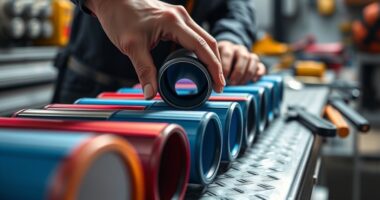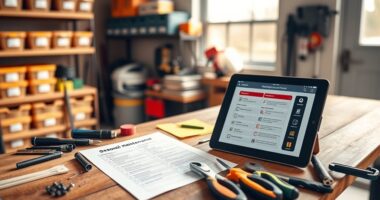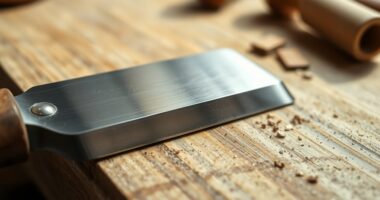To clean rust off hand planes with electrolysis at home, you’ll need a non-metallic container, washing soda, a power supply, and a sacrificial anode. Attach the rusted tool to the negative lead and the anode to the positive, then submerge both in the electrolyte solution. Turn on the power and watch the rust lift away safely. If you want detailed steps and safety tips, there’s more to explore to get your tools looking great again.
Key Takeaways
- Prepare a saturated washing soda solution and submerge the rusted hand plane in it for electrolysis.
- Connect the tool as the cathode (negative) and use a sacrificial anode as the positive electrode.
- Operate the setup in a well-ventilated area with safety gear, monitoring bubbling during the process.
- Turn off power, rinse the hand plane thoroughly, and dry immediately to prevent new rust formation.
- Electrolysis effectively removes rust without damaging the metal, restoring the tool’s surface and integrity.

Have you ever wondered how to restore your hand planes when rust takes over? If so, electrolysis is a highly effective method you can do at home, but it requires careful attention to electrolysis safety and proper hand tool maintenance. Rust can be stubborn, but electrolysis allows you to remove it gently without damaging the metal underneath. Before diving in, it’s vital to understand the safety precautions involved. Electrolysis involves using electricity, so you should operate in a well-ventilated area, wear gloves, and avoid any contact with water and electrical components. Always guarantee your work area is dry, and never leave the setup unattended. Using the correct safety gear, like eye protection, helps prevent accidents, especially if the solution bubbles or splatters. When you follow proper electrolysis safety protocols, you reduce the risk of electrical shock or chemical exposure, making the process safer and more effective.
To start, you’ll need a non-metallic container large enough to hold your hand plane and a power supply, ideally a simple battery charger or a DC power source. You’ll also need washing soda (sodium carbonate) to create the electrolyte solution. Dissolve enough washing soda in water until it’s fully saturated, creating a conductive bath. Submerge the rusted hand plane in this solution, attaching the negative lead of your power source to the item. For the anode, use a sacrificial piece of scrap steel or iron, connected to the positive lead, and submerge it as well. When you turn on the power, electrolysis begins, and the rust gradually lifts off the metal surface. You’ll see bubbling and fizzing, which indicates the process is working. Keep a close eye on the setup, ensuring everything remains submerged and stable. During this process, your focus should be on effective hand tool maintenance: removing rust without harming the tool’s integrity. Electrolysis is gentle enough to preserve the original metal, meaning your hand plane will be restored without the risk of uneven pitting or surface damage typical of abrasive methods. Additionally, choosing the right sacrificial anode can help optimize rust removal efficiency and protect the tool’s surface.
Once the rust has loosened, turn off the power, and carefully remove the hand plane from the solution. Rinse it thoroughly with clean water to remove any residual electrolyte and rust debris. Pat it dry immediately to prevent new rust from forming. After cleaning, inspect the tool for any remaining corrosion and consider applying a light coat of oil or wax to protect it from future rust. This process not only revitalizes your hand plane but also reinforces your skills in hand tool maintenance. With patience and proper safety measures, electrolysis becomes a reliable way to keep your tools in top shape, extending their life and performance.
Frequently Asked Questions
Can Electrolysis Damage the Wood Parts of the Hand Plane?
You wonder if electrolysis can damage the wood parts of your hand plane. Generally, it doesn’t harm the wood if you protect it properly, but you should focus on wood preservation by avoiding prolonged exposure to electrical current. Always prioritize electrical safety by ensuring the plane is dry and insulated. Using plastic or rubber parts to cover the wood helps prevent any potential damage, keeping your tool in great shape.
How Long Does the Electrolysis Process Typically Take?
The electrolysis duration for rust removal time varies depending on rust severity and setup. Generally, it takes anywhere from 1 to 6 hours for effective cleaning. You’ll see rust loosen and bubble up during this process. Keep an eye on it, and check periodically to avoid overdoing it. This method is efficient, but patience is key to assure thorough rust removal without damaging your hand plane.
Is Electrolysis Safe for Beginners to Try at Home?
It’s a coincidence that electrolysis, often linked to industrial processes, can be a safe beginner project at home if you follow the right safety precautions. As a beginner, you should wear gloves, goggles, and work in a well-ventilated area. Use beginner tips like keeping electrical connections dry and avoiding metal contact. When done carefully, electrolysis becomes a safe, effective way to remove rust from tools like hand planes.
What Are the Environmental Impacts of Electrolysis Rust Removal?
When considering the environmental impacts of electrolysis rust removal, you should be aware of potential environmental concerns. The process produces chemical waste, including used electrolyte solutions, which can harm soil and water if not disposed of properly. You’re responsible for managing waste safely, using eco-friendly disposal methods. Although electrolysis is effective, it’s important to minimize chemical waste and follow local regulations to reduce its environmental footprint.
Can Electrolysis Be Used on Other Rusty Metal Tools?
Yes, electrolysis can be used on other rusty metal tools. It’s an effective method compared to alternative cleaning techniques, especially for delicate or intricate parts. When using electrolysis, you can also apply rust prevention techniques afterward, like applying oil or paint, to help protect your tools. Just guarantee you set up the process properly and follow safety precautions to avoid damage or injury during rust removal.
Conclusion
Now that you’ve learned how to clean rust off your hand planes with electrolysis, you’re like a metal doctor reviving a tired tool. Just remember, patience is key—think of it as restoring a treasured heirloom. With a little effort, your hand plane will shine like new, ready to tackle your next woodworking project. So go ahead, roll up your sleeves and give electrolysis a try—it’s simple, effective, and satisfying, like turning back the clock on your rusty tools.









